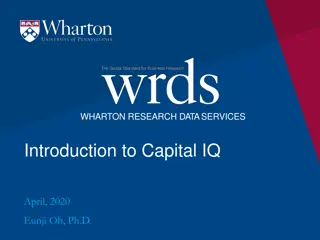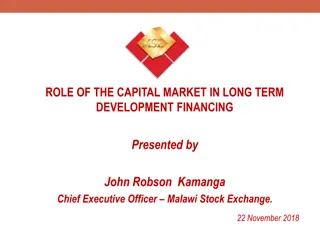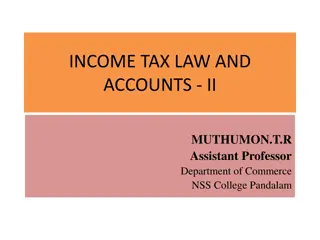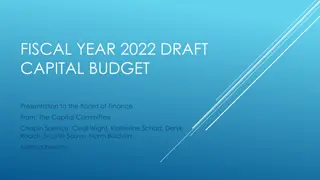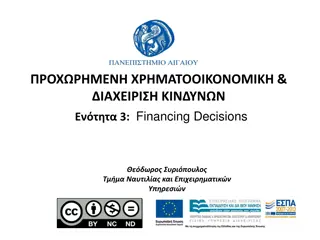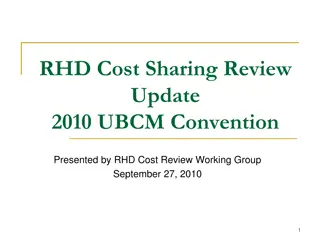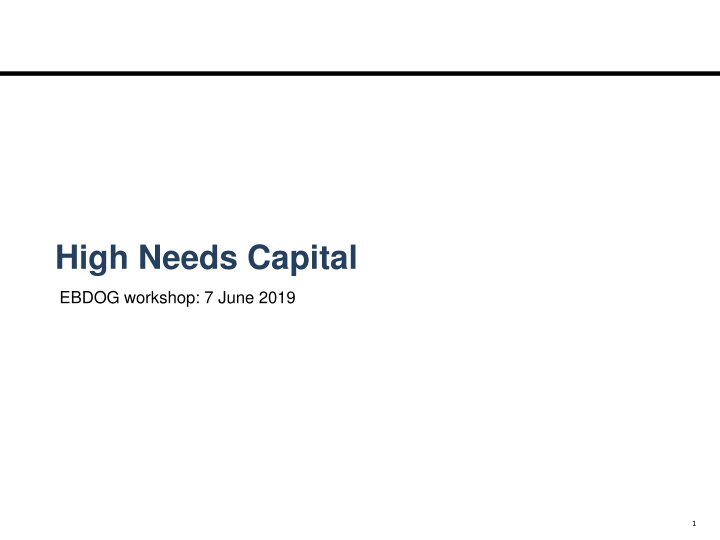
Impact of High Needs Capital in Education System
Explore the challenges and strategies related to high needs capital in education, including the increasing demand for EHCPs, budget constraints, and the role of specialized schools. Learn about recent developments in capital funding allocations, the new Ofsted framework, and the Timpson review of exclusions.
Download Presentation

Please find below an Image/Link to download the presentation.
The content on the website is provided AS IS for your information and personal use only. It may not be sold, licensed, or shared on other websites without obtaining consent from the author. If you encounter any issues during the download, it is possible that the publisher has removed the file from their server.
You are allowed to download the files provided on this website for personal or commercial use, subject to the condition that they are used lawfully. All files are the property of their respective owners.
The content on the website is provided AS IS for your information and personal use only. It may not be sold, licensed, or shared on other websites without obtaining consent from the author.
E N D
Presentation Transcript
High Needs Capital EBDOG workshop: 7 June 2019 1
Context: an increase in children with EHCPs, and increasing reliance on specialist and independent settings Increase in EHCP volumes driven by demographic growth, and increasing EHCP rates 11% increase between January 2018 and 2019 Increases more pronounced at post-16 level and for primary age children Compounding effect as demographic bulge moves through the system Increased demand on the High Needs budget, driven by: Demographic growth Increasing EHCP rates Drift towards more specialist provision 2
The capital story so far: capital direct to LAs + special and AP free schools Capital funding allocations to LAs increased from 215m to 365m, 2018-21 Ramped up delivery of special and AP free schools: Opening AP and special free schools has shown that the commitment from local authorities is important so that the new schools complement the local education offer and are a close match for what families need. Changes to the process for opening new special and AP schools to allow local authorities to set out their case for why a new special or AP free school would benefit their area. In March, we approved 39 bids from LA bids to establish new schools through this route This approach enables us to establish new schools that fit within local authorities strategies and are therefore effective, cost efficient and best meet the needs of children. Type Open (2011-now) Pipeline (expected to open by 2023) 34 43 91 13 Special free schools AP free schools 3
New Ofsted framework Ofsted published its new inspection framework for early years, schools and post-16 education on 14 May alongside its response to the consultation on the framework. The consultation ran from 16 January to 5 April and received 15,000 responses. The new arrangements include a stronger focus on the curriculum through a new quality of education judgement and on reducing workload. The new schools handbook makes clear schools should have an inclusive culture that ensures the needs of all pupils are met. The new framework will be implemented from September 2019. Ofsted handbook: inclusion and off-rolling 253. Schools should have an inclusive culture that supports arrangements to: identify early those pupils who may be disadvantaged or have additional needs or barriers to learning meet the needs of those pupils, drawing, when necessary, on more specialist support, and help those pupils to engage positively with the curriculum ensure pupils have a positive experience of learning and achieve positive outcomes. 4
Timpson review of exclusions Timpson s review is clear about the need for calm and safe environments, and is clear about the role exclusions play in creating those. It also sets out that we need to do more, around four pillars to ensure exclusion is always used well. Four pillars for reform Ambitious leadership that sets high expectations for every child Including new guidance and training for school leaders, and clearer duties to work together with LAs and others to plan to understand and plan to meet pupil needs. Including better core training for all teachers, improving the quality of alternative provision and elevating its status to in the system to deliver expert support and continue to invest in multi- agency support for schools. Better equipped schools that have the capacity and skills to deliver Four government commitments 1. Support head teachers to maintain safe and orderly environments Including ensuring schools have a long term interest in pupils by making them accountable for the outcomes of excluded children, and ensuring governor reviews offer effective challenge and scrutiny. The right incentives that create the conditions to deliver for every child 2. Support schools & partners to put in place effective preventative interventions Including putting in place safeguards to ensure no child slips through the net because they are off-rolled or excluded for multiple fixed periods, and taking action to prevent children becoming drawn into crime and violence 3. Clarify when and how it is appropriate for children to be removed Safeguards to ensure no child misses out on education 4. Support schools & alternative provision (AP) settings serving excluded pupils 5
Forecasting demand for places in different setting types Start with school census Cohort progression at LA level based on recent trends Forecast total pupils at LA level Take actual EHCP rates from 2011/12 onwards (including pre-EHCP system) Project forward using trends Forecast EHCP rates Take current splits Make assumptions about trends Factor in role of capital implied in continuing and changing those trends Forecast destinations How the split between the different provision settings evolves Whether EHCP rates will continue along current projections The main unknowns in this are: Accuracy of ONS projections of populations aged 4 for each future year 6
The AP pupil population oThe pupil population in PRUs, AP academies, and AP free schools has been growing at a faster rate than that of mainstream and special schools. oOverall LA spending on AP has remained roughly consistent over recent years, at around 10% of the high needs budget. oThe government s response to the Timpson review committed to seek, in the next spending review, to secure capital funding for improving and expanding buildings and facilities, including for children who may require AP so that children in AP have access to high quality facilities so that they receive a curriculum on a par with mainstream. NB: Pupil population in state-funded mainstream changed from 7,519,700 in 2013 to 7,974,695 (29% increase) in 2018, compared to PRUs, AP Academies, and AP free schools which changed from 12,950 in 2013 to 16,730 (6% increase) in 2018. Source: https://www.gov.uk/government/collections/statistics-school-and-pupil-numbers;
Our known unknowns: Remodelled places, SEN places in mainstream, accessibility Re-providing SEN places SEN places in mainstream What we did: Accessibility What we did: What we did: The Equality Act 2010 sets out the legal obligations that schools, early years providers, post-16 institutions, local authorities and others have towards disabled children and young people. All schools have duties under the Equality Act 2010 towards individual disabled children and young people. Some LAs described undertaking projects in mainstream schools without an SEN unit, which included building or re-providing places they categorised as SEN places. On behalf of the DfE, Mott MacDonald asked 11 local authorities (LAs) about specific projects from 2015-17 SCAP returns, where basic need funding had been used to re- provide SEN places. We wanted to understand how local authorities are responding, and supporting schools to respond, to these duties. By accessibility works we refer to physical adjustments to buildings so that pupils with physical disabilities can access education provision. LAs were asked to explain why these places were described as SEN places . LAs were asked to explain why they had re-provided these places. What we found out: For 8 out of 27 projects discussed, re-provided places were categorised as SEN places because the places were expected to be occupied by pupils with EHCPs, despite the school not having a SEN unit or resourced provision. What we found out: What we found out: Approaches varied between LAs, though the majority (9 out of 11) set aside a fund for accessibility works in schools either for all schools in their area, or where they were the responsible body. Out of 27 projects, the majority of projects were attributed either to a need to facilitate school expansions (9 projects) or a change in the type of SEN need being met (7 projects). Annual funding reserved for accessibility works ranged from c. 100,000 to over 1m. Most LAs (7 out of 11) reported that their level of investment had stayed broadly the same over the past 5 years. 10 projects were also linked to needing to add better facilities to existing places. Next steps: This insight is helping us to increase our understanding of how capital funding is being used to support SEND provision and accessibility. This will feed into our ongoing policy work and evaluation. 8
More known unknowns: post-16 places and FE Post-16, the majority of young people with EHCPs in education, attend an FE setting. Through a limited consultation, FE colleges told us the types of spaces that post-19 pupils with SEND need include: Flexible Adjustable kitchen spaces Garden space Individual, accessible toilets Time-out/breakout spaces Sensory rooms Specialist facilities Simulated work environments Large rooms Discrete Wide corridors Disabled changing facilities. Good IT facilities Secure Storage space Durable, versatile furniture Hearing loops/disability access Medical spaces Main takeaways: All stakeholders wanted more and improved spaces. Preparation for adulthood: general consensus that students benefit most from gaining extensive experience in the workplace. Priorities for capital spend: increasing the number of breakout, medical/therapy and storage spaces investing in modular classrooms, for greater flexibility Creating industry-standard and state-of-the-art simulated work environments. Remodelling spaces to be larger, more secure and bespoke. 9
Feedback and discussion 1. Please participate in the call for evidence on funding for children with SEND and who require Alternative Provision (closes 31 July): https://consult.education.gov.uk/funding-policy- unit/funding-for-send-and-those-who-need-ap-call-for-ev/ 2. What is your overall strategy for dealing with High Needs pressures? 3. What is the role of capital in that? How directly do you link the two for example in terms of associating capital spend with revenue savings? 4. What could DfE do to support local authorities? 5. We currently provide capital allocations to local authorities, and build new special free schools through a central bidding round. What balance should we look for going forwards? 6. How best should we look to ensure sufficient and suitable places exist for post-16 young people? 10










